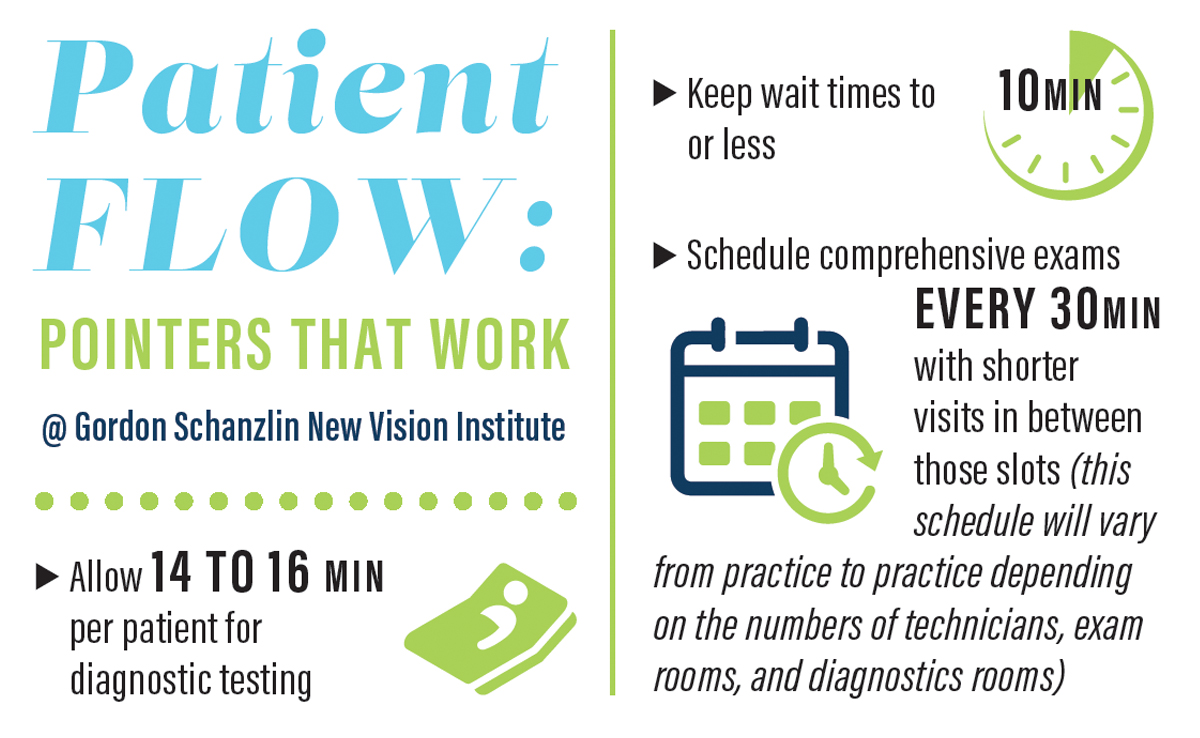On any given day at Gordon Schanzlin New Vision Institute in La Jolla, California, we provide care to about 80 patients—coming to us for services that range from cataract surgery, refractive lens exchange, and laser vision correction to keratoconus, dry eye disease, diabetic retinopathy, and aesthetic services. With such a demanding patient schedule and the wide variety of treatments we offer, one of the most important tools that we have on our side is impeccable patient flow.
In this article, I outline tips that we’ve learned through the years that can help any practice to maximize its patient flow and, in turn, aid in strengthening overall efficiency.
IT STARTS AT THE FRONT (DESK)
A successful patient flow process keeps patients moving efficiently through the halls of the practice. At our combined MD/OD practice, good patient flow starts at the front desk. As patients check in, the front desk staff is warm and welcoming but also constructive in helping patients get settled into the office quickly. This is done in an ultimate effort to facilitate the timely completion of paperwork.
Often patients will show up either right at their appointment time or even a few minutes late. When a patient is scheduled for a consultation at 8 am but doesn’t show up until 8:05 am, and there is a stack of paperwork to fill out before he or she can be seen, it can put everyone behind for the rest of the day. The front desk staff members must be trained to manage that interrupted flow and to act as gatekeepers between the front-office and clinical staffs. Vice versa, if the consultation or surgical staff is running behind schedule, front desk personnel should be able to manage the patients still in the waiting room so that they don’t feel forgotten. Our goal is to keep patient wait times to 10 minutes or less.
In an effort to cut wait times down to the bare minimum, our front desk schedules comprehensive exams every 30 minutes. Shorter visits—for example a contact lens follow-up—can be scheduled in between those 30-minute slots. This schedule would undoubtedly vary from practice to practice, depending on the numbers of technicians, exam rooms, and diagnostic (ie, pretest) rooms available.
Another factor to consider is that many practices don’t have duplicate diagnostic equipment, so ushering patients through testing in the pretest room can be challenging. Is the room big enough that multiple patients can be processed at the same time? Or is it only conducive to testing one patient at a time? The pretest room is the main bottleneck for many practices, including ours.
AVOID THE BOTTLENECK
At our practice, diagnostic testing typically takes 14 to 16 minutes per patient. The most important element in making sure that patient flow does not bottleneck in the pretest room is simply tasking the front desk staff with scheduling patients far enough apart that five people do not all show up at once for diagnostic testing. (This is, however, easier said than done. It takes a dedicated and well-educated staff to accomplish this.)
The other key is that technicians must also be well aware of patient flow. As they take patients back to the pretest room, they must keep an eye on who is already back there, know where the doctor is, and monitor the relative progress between the diagnostics exams and the other steps of the consultation process. This is crucial so that patients are not waiting in an exam room by themselves for an hour after they’ve finished their diagnostic testing.

MIND THE PATIENT
Every patient is different. Some are slow and need the technician to guide them along the process, for example. A big part of facilitating flow with a slow patient is knowing whether to delay certain tests until after the patient has spoken with the doctor. This can help to keep the doctor on schedule, which is the main reason to focus on maximizing patient flow.
Other patients may simply be more difficult than anticipated. They may ask a lot of questions or require in-depth explanations, or they may have a condition or complication that requires a call to a specialist for more information. In these circumstances, the best thing one can do is to be compassionate and keep in mind that lag time may be made up during the next patient consult, in the event that (hopefully) the next patient has fewer questions or requires less explanation.
Language can also be a barrier. In Southern California, we see a lot of patients who speak Spanish, Chinese, and Vietnamese. Having staff that can speak one or more of these languages is extremely helpful. Even so, when someone has to translate, it slows down the consultation process. The best tool in these situations is to have the front desk staff communicate to the rest of the team—technicians, counselors, and doctors—that a translator will be accompanying this patient during his or her appointment.
Another thing that is especially helpful with cataract surgery patients is to have front-end staff mention to the patient prior to his or her appointment that it’s beneficial to have a family member or friend in the room to help the patient process the tremendous amount of information that will be covered. That additional person can also reiterate to the patient what the surgeon has said and reinforce those messages.
Lastly, sometimes emergency patients must be fit into an already busy schedule. This can cause a disruption of the schedule, but, of course, it is imperative that these patients be seen and managed as quickly and efficiently as possible.
CONCLUSION
If one’s goal is to improve patient flow, the importance of staff training can’t be emphasized enough. The bottom line is this: If the patient does not have good relationships with your staff members, and if the experience of the visit is not positive, he or she won’t come back to your practice. Make sure that the entire practice staff is very good at communication, that they are great at handling patients and handholding when needed, and that they are knowledgeable about the flow of the entire practice.
Our practice offers refractive surgery and refractive cataract surgery. We implant a large number of premium IOLs and perform a lot of customized refractive surgery. Patients pay a premium for our services, and the more they pay, the more they demand—and the more handholding is typically required. Being able to handle patient concerns and questions and to do so with the right attitude and in an efficient amount of time is key to a practice’s success, especially in a high-end practice like ours. Make sure that all of your patients know that their once-in-a-lifetime decision to place their eye care in your hands is important to you, and make sure they know that you and your staff celebrate their choice.






